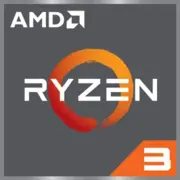AMD Ryzen 3 7440U

AMD Ryzen 3 7440U: A Balance of Mobility and Performance for Ultrabooks
Introduction
The AMD Ryzen 3 7440U is a processor designed for thin and light laptops, combining the modern Zen 4 architecture with the energy efficiency of 4nm manufacturing technology. Developed under the codename Phoenix2, it is positioned as a solution for users who prioritize battery life, moderate performance for everyday tasks, and the ability to run less demanding games. This article will explore who this chip is suitable for and the advantages it offers.
Architecture and Manufacturing Process: Zen 4 and RDNA 3 in a Compact Form
Zen 4: Transition to 4nm
The Ryzen 3 7440U is built on the Zen 4 architecture, which debuted in 2023. Key features include:
- 4 cores and 8 threads — multithreading capability for parallel tasks.
- Base clock of 3.0 GHz, with a maximum turbo frequency of up to 4.7 GHz.
- 8MB of L3 cache — reducing latency when handling data.
- TSMC 4nm manufacturing process — higher transistor density and lower energy consumption.
Integrated Graphics Radeon 740M
The Radeon 740M iGPU is based on the RDNA 3 architecture:
- 4 Compute Units (CU) — 256 stream processors.
- Clock speed up to 2.5 GHz — sufficient for Full HD gaming in light projects.
- Support for HDMI 2.1 and DisplayPort 2.1 — outputting to 4K monitors at 120 Hz.
Example: In games like CS:2 or Fortnite, the Radeon 740M delivers around 40-50 FPS at medium settings in 1080p resolution. For esports titles, this is acceptable, but demanding AAA games will require lowering quality settings to Low.
Power Consumption and TDP: A Balance Between Power and Battery Life
TDP of 28W — a standard figure for upper-segment ultrabook processors. However, thanks to the 4nm manufacturing process, the Ryzen 3 7440U shows flexibility:
- Under minimal load, the chip reduces its consumption to 5-10W.
- Under peak load (e.g., video rendering), power can temporarily reach up to 35W.
Power saving technologies include:
- Precision Boost 2 — dynamic frequency boosting for individual cores.
- AMD PowerNow! — adaptive voltage and frequency management.
- Windows Power Modes (such as "Battery Saver") — synchronization with the OS to extend battery life.
Performance: From Office Tasks to Light Gaming
Office Tasks and Multimedia
- Geekbench 6: 2311 (Single-Core), 6533 (Multi-Core). For comparison: Intel Core i5-1335U scores around ~2200/6200, Apple M1 scores ~2400/7500.
- Real-World Scenarios:
- Running 20 Chrome tabs + working in Excel — no lag.
- Photo processing in Lightroom — exporting 100 images in 2-3 minutes.
- 1080p video editing in DaVinci Resolve — smooth preview with simple effects.
Turbo Mode: When Maximum Power is Needed
When turbo mode is activated (e.g., via laptop software settings), the processor maintains frequencies of 4.5-4.7 GHz for 20-30 seconds. This is useful for short bursts of activity, but under extended use (more than 5 minutes), throttling may occur due to overheating.
Tip: For stable performance in gaming or rendering, use a cooling pad.
Usage Scenarios: Who is the Ryzen 3 7440U Suitable For?
1. Students and Office Workers — quick document handling, video conferencing.
2. Digital Artists — drawing in Photoshop, light editing.
3. Casual Gamers — games like The Sims 4, Rocket League.
4. Portability Enthusiasts — laptops based on the 7440U rarely weigh over 1.5 kg.
Example Device: Lenovo Yoga Slim 5 with a 14" screen and up to 10 hours of battery life.
Battery Life: How Long Will the Laptop Last?
With a battery capacity of 50-60 Wh:
- Video playback (1080p): 8-10 hours.
- Office work: 7-9 hours.
- Gaming: 2-3 hours.
Factors Affecting Battery Life:
- Screen brightness.
- Activity of background applications.
- Use of Wi-Fi/Bluetooth.
Tip: Disable unnecessary services in the task manager and use dark themes for AMOLED screens to enhance battery life.
Comparison with Competitors
AMD Ryzen 5 7540U
- Pros: 6 cores, Radeon 760M (8 CU).
- Cons: Pricing for laptops is 20-30% higher.
Intel Core i5-1335U
- Pros: Better single-core performance in some applications.
- Cons: Iris Xe graphics lag behind Radeon 740M by 15-20%.
Apple M1
- Pros: Record battery life, optimization for macOS.
- Cons: Limited gaming software availability, high price.
Conclusion: The Ryzen 3 7440U is optimal for Windows laptops in the $600-800 price range.
Pros and Cons of the Processor
Strengths:
- Energy efficiency of the 4nm process.
- Strong graphics performance for the segment.
- Support for DDR5 and PCIe 4.0.
Weaknesses:
- Only 4 cores — multi-threaded tasks (rendering, code compilation) are performed slower than with 6-core competitors.
- Limited availability of laptops featuring this chip on the market.
Recommendations for Choosing a Laptop
1. Device Type: Ultrabook or 2-in-1 hybrid with a screen size of 13-14 inches.
2. Screen: IPS panel with Full HD resolution or OLED for contrast.
3. RAM: 16GB LPDDR5 — reduces the risk of lag during multitasking.
4. Storage: SSD with at least 512GB (minimum NVMe PCIe 3.0).
5. Cooling: Check reviews on the noise level of fans under load.
Examples of Models: HP Pavilion Aero 13, ASUS Vivobook S 14.
Final Conclusion
The AMD Ryzen 3 7440U is an excellent choice for those looking for a compact laptop with a performance buffer for work and entertainment. It's suitable for:
- Users tired of the "lag" typical with budget Intel laptops.
- Those who value battery life but do not wish to sacrifice the ability to run games.
- Buyers focusing on modern standards (DDR5, Wi-Fi 6E).
Key Benefits: A balance of price and performance, readiness for the future (hardware support for AI workloads), versatility. If you don't need maximum power but value mobility — consider the Ryzen 3 7440U.
Basic
CPU Specifications
Memory Specifications
GPU Specifications
Miscellaneous
Benchmarks
Compared to Other CPU
Share in social media
Or Link To Us
<a href="https://cputronic.com/cpu/amd-ryzen-3-7440u" target="_blank">AMD Ryzen 3 7440U</a>